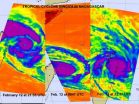(Press-News.org) MADISON — Recalculating the global use of phosphorous, a fertilizer linchpin of modern agriculture, a team of researchers warns that the world's stocks may soon be in short supply and that overuse in the industrialized world has become a leading cause of the pollution of lakes, rivers and streams.
Writing in the Feb. 14 edition of the journal Environmental Research Letters, Stephen Carpenter of the University of Wisconsin-Madison and Elena Bennett of McGill University report that the human use of phosphorous, primarily in the industrialized world, is causing the widespread eutrophication of fresh surface water. What's more, the minable global stocks of phosphorous are concentrated in just a few countries and are in decline, posing the risk of global shortages within the next 20 years.
"There is a finite amount of phosphorous in the world," says Carpenter, a UW-Madison professor of limnology and one of the world's leading authorities on lakes and streams. "This is a material that's becoming more rare and we need to use it more efficiently."
Phosphorous is an essential element for life. Living organisms, including humans, have small amounts and the element is crucial for driving the energetic processes of cells. In agriculture, phosphorous mined from ancient marine deposits is widely used to boost crop yields. The element also has other industrial uses.
But excess phosphorous from fertilizer that washes from farm fields and suburban lawns into lakes and streams is the primary cause of the algae blooms that throw freshwater ecosystems out of kilter and degrade water quality. Phosphorous pollution poses a risk to fish and other aquatic life as well as to the animals and humans who depend on clean fresh water. In some instances, excess phosphorous sparks blooms of toxic algae, which pose a direct threat to human and animal life.
"If you have too much phosphorous, you get eutrophication," explains Carpenter of the cycle of excessive plant and algae growth that significantly degrades bodies of fresh water. "Phosphorous stimulates the growth of algae and weeds near shore and some of the algae can contain cyanobacteria, which are toxic. You lose fish. You lose water quality for drinking."
The fertilizer-fueled algae blooms themselves amplify the problem as the algae die and release accumulated phosphorous back into the water.
Carpenter and Bennett write in their Environmental Research Letters report that the "planetary boundary for freshwater eutrophication has been crossed while potential boundaries for ocean anoxic events and depletion of phosphate rock reserves loom in the future."
Complicating the problem, says Carpenter, is the fact that excess phosphorous in the environment is a problem primarily in the industrialized world, mainly Europe, North America and parts of Asia. In other parts of the world, notably Africa and Australia, soils are phosphorous poor, creating a stark imbalance. Ironically, soils in places like North America, where fertilizers with phosphorous are most commonly applied, are already loaded with the element.
"Some soils have plenty of phosphorous, and some soils do not and you need to add phosphorous to grow crops on them," Carpenter notes. "It's this patchiness that makes the problem tricky."
Bennett and Carpenter argue that agricultural practices to better conserve phosphate within agricultural ecosystems are necessary to avert the widespread pollution of surface waters. Phosphorous from parts of the world where the element is abundant, they say, can be moved to phosphorous deficient regions of the world by extracting phosphorous from manure, for example, using manure digesters.
Deposits of phosphate, the form of the element that is mined for agriculture and other purposes, take many millions of years to form. The nations with the largest reserves of the element are the United States, China and Morocco.
###
The new study was supported by grants from the U.S. National Science Foundation and the Natural Sciences and Engineering Research Council of Canada.
Terry Devitt, 608-262-8282, trdevitt@wisc.edu
World phosphorous use crosses critical threshold
2011-02-15
ELSE PRESS RELEASES FROM THIS DATE:
George Clooney or Saddam Hussein? Why do consumers pay for celebrity possessions?
2011-02-15
A new study in the Journal of Consumer Research sheds some light into why someone would pay $48,875 for a tape measure that had belonged to Jackie Kennedy or $3,300 for Bernie Madoff's footstool.
"Why do people pay money for celebrity possessions?" write authors George E. Newman (Yale University), Gil Diesendruck (Bar-Ilan University), and Paul Bloom (Yale University). "Celebrity items often have little functional value. And because the objects themselves tend to be relatively common artifacts (clothing, furniture, etc.) they are often physically indistinguishable from ...
How do consumers react when friends provide poor service in a business arrangement?
2011-02-15
When your friend is a service provider, things can get complicated. According to a new study in the Journal of Consumer Research, a problem can lead to feelings of betrayal or empathy, depending on the circumstances.
"Imagine that you are planning to celebrate your birthday at your favorite restaurant. You ask the owner to hold a sea-view table for you and he indicates that he will try to do so. When you arrive at the restaurant, however, he tells you that all of the sea-view tables have been taken. What would your reaction be?" write authors Lisa C. Wan (Lingnan University), ...
NASA satellites see Cyclone Bingiza move across northern Madagascar
2011-02-15
Tropical Cyclone Bingiza has made landfall in northeastern Madagascar, and NASA's Aqua and Terra satellites captured visible infrared satellite data of the storm's progression over the weekend, revealing the power behind the storm.
The movement and landfall of Tropical Cyclone Bingiza was captured over the weekend of Feb. 12-13 in a series of infrared satellite imagery from the Atmospheric Infrared Sounder (AIRS) instrument that flies aboard NASA's Aqua satellite. Aqua and Terra provided companion visible images to the infrared images of Bingiza's track across northern ...
Heart patients should be referred to Cardiac Rehabilitation before leaving hospital
2011-02-15
Healthcare practitioners can increase the number of patients with heart disease referred to a cardiac rehabilitation program by 40 per cent, helping them to reduce their risk of dying and improve their quality of life, say researchers at the Peter Munk Cardiac Centre.
Previous studies, including one by Taylor in 2004, indicate that participating in cardiac rehab after a cardiac illness, such as a heart attack, can reduce the risk of death by approximately 25 per cent, a reduction similar to that of other standard therapies such as cholesterol-lowering medications (statins) ...
Earliest humans not so different from us, research suggests
2011-02-15
That human evolution follows a progressive trajectory is one of the most deeply-entrenched assumptions about our species. This assumption is often expressed in popular media by showing cavemen speaking in grunts and monosyllables (the GEICO Cavemen being a notable exception). But is this assumption correct? Were the earliest humans significantly different from us?
In a paper published in the latest issue of Current Anthropology, archaeologist John Shea (Stony Brook University) shows they were not.
The problem, Shea argues, is that archaeologists have been focusing ...
Rising seas will affect major US coastal cities by 2100
2011-02-15
Rising sea levels could threaten an average of 9 percent of the land within 180 U.S. coastal cities by 2100, according to new research led by University of Arizona scientists.
The Gulf and southern Atlantic coasts will be particularly hard hit. Miami, New Orleans, Tampa, Fla., and Virginia Beach, Va. could lose more than 10 percent of their land area by 2100.
The research is the first analysis of vulnerability to sea-level rise that includes every U.S. coastal city in the lower 48 with a population of 50,000 or more.
The latest scientific projections indicate that ...
Monitoring killer mice from space
2011-02-15
SALT LAKE CITY, Feb. 15, 2011 – The risk of deadly hantavirus outbreaks in people can be predicted months ahead of time by using satellite images to monitor surges in vegetation that boost mouse populations, a University of Utah study says. The method also might forecast outbreaks of other rodent-borne illnesses worldwide.
"It's a way to remotely track a disease without having to go out and trap animals all the time," says Denise Dearing, professor of biology at the University of Utah and co-author of the study published online Wednesday, Feb. 16, in the journal Global ...
Breast cancer screening with MRI benefits women with radiation therapy history
2011-02-15
OAK BROOK, Ill. – Breast cancer screening with MRI can detect invasive cancers missed on mammography in women who've undergone chest irradiation for other diseases, according to a new study published online and in the April print edition of Radiology.
Women who receive radiation therapy as children and young adults for diseases like Hodgkin's lymphoma face a significantly greater risk of breast cancer later in life. The incidence of breast cancer increases approximately eight years after chest irradiation, and 13 percent to 20 percent of women treated with moderate- to ...
Updated heart disease prevention guidelines for women focus more on 'real-world' recommendations
2011-02-15
Practical medical advice that works in the "real world" may more effectively prevent cardiovascular disease in women than recommendations based only on findings in clinical research settings, according to the 2011 update to the American Heart Association's cardiovascular disease prevention guidelines for women.
First published in 1999, the guidelines until now have been primarily based on findings observed in clinical research. That alone often doesn't consider the personal and socioeconomic factors that can keep women from following medical advice and treatment.
"These ...
New study finds no cognitive impairment among ecstasy users
2011-02-15
The drug known as ecstasy has been used by 12 million people in the United States alone and millions more worldwide. Past research has suggested that ecstasy users perform worse than nonusers on some tests of mental ability.
But there are concerns that the methods used to conduct that research were flawed, and the experiments overstated the cognitive differences between ecstasy users and nonusers.
In response to those concerns, a team of researchers has conducted one of the largest studies ever undertaken to re-examine the cognitive effects of ecstasy, funded by a ...


